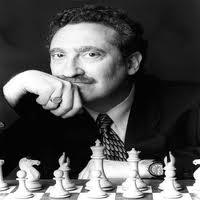
Pandolfini's Puzzler #46 - The Fortress and the Cage, Part 1
Professor: Good evening, class.
Lucian: Good evening? But it’s only one o’clock in the afternoon.
Professor: Oh, forgive me. I’ve just flown back from Phnom Penh and I forgot to reset my watch.
Here, the class wasn’t sure if the Professor was having a flight of fancy or merely trying to tell a joke. Zephyr, the most experienced student in the class, decided to help things along.
Zephyr: What were you planning to talk about today, Professor?
Professor: I thought we might look at a few ways to save materially losing positions.
Hale: You mean by drawing?
Professor: Yes. That’s exactly what I mean.
Thomas: Are we talking about stalemates?
Professor: No, I was thinking more about positional draws.
Rachel: What kinds of positional draws?
Professor: I was planning to focus on impassable defensive sectors and barriers, such as fortresses and cages.
Ryan: I think I get a sense for what a chess cage is, but I’m not clear on the concept of the chess fortress.
Thomas: It seems a lot of Russian players like to use that term.
Hale: Actually, players from many different places.
Lucian: You’re not talking about forts like the Alamo, right? It didn’t work for Davy Crockett.
Professor: And it doesn’t quite work here either.
Rachel: So what is a fortress?
Professor: Very loosely, the term “fortress” refers to a setup where the superior side is unable to infiltrate or pass through a defended region to exploit its material advantage.
Ryan: Most of us just call that a positional draw.
Professor: Yes, but we’re not most of us. Besides, there are other types of positional draws that don’t quite fit into the category.
Rachel: Could you give us an example of a fortress?
Professor: Of course. Please consider our first position.
Question 1: Can White set up a fortress?
Professor: Black to play has several winning moves. But White to move can hold by simplifying to a fortress.
Ryan: Of course it’s a draw. It’s just the concept of having “the wrong bishop.”
Thomas: But we see what you mean. After the initial reductive sacrifice, there’s no way for Black to break through, even with the extra material.
Professor: Right. Anyhow, here’s another simple one.
Question 2: Can White set up a fortress?
Lucian: I know that problem. The position becomes a situation where Black’s king is unable to support the h2-pawn without causing stalemate.
Ryan: So that’s really a fortress, too.
Professor: Let’s look at another one to reinforce the concept.
Question 3: Can White find a way to draw?
Zephyr: Wow! That leads to another positional draw.
Thomas: Fascinating. The situation condenses to a comparable fortress.
Professor: You’re on a roll, class. Let’s look at another.
Question 4: Can White achieve a fortress?
Zephyr: You’re right. If White plays correctly, there’s no way for Black to penetrate.
Lucian: White is lucky that Black doesn’t have two dark-square bishops.
Hale: I guess you can say White is lucky.
Ryan: But please don’t.
Professor: Lucky or not, let’s take a gander at our next offering.
Question 5: Can White draw?
Rachel: So that also leads to a fortress.
Ryan: True, even though Black can prevent White’s king from getting to b1, and then the corner, White can still keep Black out.
Professor: Let’s examine another knight-pawn problem. See if you can find a fortress here.
Question 6: Can White save the game?
Ryan: That’s a nice fortress.
Thomas: In the end, it’s also one of those cases where more turns out to be less.
Rachel: And less turns out to be more.
Professor: More so, let’s see how less does in our next example.
Question 7: Can White escape with a draw?
Zephyr: That’s not a technical fortress.
Lucian: Yet it has the feel of a fortress.
Hale: I like it!
Professor: Great! Let me see if you also like the next one.
Question 8: Can White set up a fortress?
Thomas: Now that leads to a real fortress.
Lucian: Yep. No king is getting into that.
Professor: True, you can’t get into the fortress, but maybe you can get into the next problem.
Question 9: Can White set up a fortress?
Ryan: It’s different, but this problem brings to mind the previous one.
Professor: I see your point. How about our next and final problem? Let’s see what it brings to mind.
Question 10: Can White set up a fortress?
The group quickly put together an answer and a fortress, and their commentary bordered on the risible. They were ready for more, but the period had come to an end.
Professor: Our time is up. We’re going to have to pursue this subject further in our next session.
Lucian: I don’t know what, but this final position reminds me of something.
Zephyr: It does?
Lucian: Yes it does.
Rachel: What, a horror story by Edgar Allan Poe?
Lucian: Well, didn't he play chess?
Zephyr: Yes, but that’s another horror story.
Answer below - Try to solve ProfessorPando's Puzzle first!
ANSWER #45
Answer 1: White can hold by 1. Be2+. Once the black king moves out of check, say 1…Kc3, White destroys the b-pawn, 2. Bxb5, and after 2…Bxb5, Black is unable to force White’s king out of the general corner, since the black bishop happens to be “the wrong bishop.” It cannot guard the a1 corner. White has a fortress.
If it were Black’s turn at the start, however, Black would win with 1…b4, 1…a6, or 1…Kc3 (or any king move, for that matter)
Answer 2: White can hold, starting with 1. Bb7+. A likely line is 1…Kd4 2. Bxf3! Nxf3 3.Kg2, and White has a fortress.
White is simply going to move the king from g2 to h1, back and forth. In order to move the knight satisfactorily (without abandoning the h-pawn), Black would first have to protect the pawn with the king. But doing so, from either g3 or h3, gives stalemate.
Answer 3: The position trims down to a fortress after 1. Rxh4+ Kxf3 2. Rxb4 Nxb4+ 3. Kb3 a2 4. Kb2. After 4…Kxg3, like the previous problem, the black king is unable to approach the main battleground too closely without inducing stalemate.
Answer 4: White can achieve a fortress with 1. Nf2, since 1…d2 is met by 2. Ne4+ Kd3 3. Nxd2. At this point, after the knight is captured, Black cannot invade White’s citadel.
As Lucian implied, however, if Black did have a second dark-square bishop, the fortress could be smashed. Victory would be set up first by establishing the black king on c3. Then Black would place one of the bishops behind the king on the d4-h8 portion of the a1-h8 diagonal. The other bishop should be positioned somewhere along the d2-h6 portion of the c1-h6 diagonal (leave c1 out of this to avoid the white king’s possible attack on c1 from b1). Black then temporizes if necessary, waiting for White’s king to move to a1. As soon as that happens, the fortress can be broken, with Black having a discovered mate by Kc3-c2.
Answer 5: White draws by 1. Bxg4! Kxg4 2. Kxe3, and Black can’t stop White’s king from retreating to c1, to the safety of a secure fortress.
Answer 6: White fashions a fortress with 1. b4!, after which Black is essentially compelled to exercise the en passant option, 1…cxb3; otherwise, if 1…Kg2 instead, the b-pawn becomes dangerous enough (2. b5) to force Black into repositioning the bishop, surrendering the c-pawn.
For instance, after 2. Kb2 Kg2 3. Ka1 Kf3 4. Kb2 Ke3 5. Ka1 Kd4 (for example) 6. Kb2 Kd3 7. Ka1, the black king can’t move to c3 or c2 because of the stalemate. And if Black tries to sac the bishop, say 7…Bb1, 8. Kxb1 Kc3 9. Kc1 is a positional draw.
It’s curious, but if the black bishop were another black pawn, Black’s connected a- and b-pawns would win easily. It would be another case of “less being more.”
Moreover, if Black went first in the original position, Black could stop the fortress from being set up by 1…Bb3!, blocking White’s b-pawn. From there, Black’s king heads toward the main battle sector, with victory not far off.
Answer 7: White can reach a drawn position. Strictly speaking, White doesn’t quite achieve a true fortress. But it is in effect, since White converts the space around the white king into a kind of no-fly zone. The drawing setup is brought about after 1. Rg7+. Now Black has three moves with his king: (A) 1...Ka8; (B) 1...Kb6; or (C) 1…Ka6.
-
If 1…Ka8, there follows 2. Ra7+ Kxa7 stalemate.
-
If 1…Kb6, then 2. Rb7+ Kc5 (if 2…Kc6, then 3. Rb6+ Kxb6 is stalemate; or if 2…Ka6, White has 3. Ra7+, and Black makes no progress) 3. Rc7+, and Black’s king can’t quite escape the checks, since crossing over to d-file, say 3…Kd5, results in a pin of the queen, 4. Rd7. So the variation reduces to a perpetual check, eventually drawing by a threefold repetition.
-
If 1…Ka6, then the rook is immune from capture after 2. Ra7+, since 2...Kxa7 is stalemate once again. And if play instead continues 2…Kb6 (instead of 2…Kxa7), White has 3. Ra6+ Kxa6, and that’s also stalemate. Meanwhile, 2…Kb5 transposes into line (B) after 3. Rb7+.
The combination of stalemate and perpetual threats construct a neutral zone, preventing Black from making progress. In essence, the white king survives in a tactical fortress of impenetrability.
Answer 8: White can save the day by 1. Qxf4+! Qxf4 2. Ne4, creating a fortress. There’s no way the black king can pierce White’s protective armor.
Answer 9: Black is threatening Qa3 and Qa4, but White can survive both threats with 1. Qxd5+! Kxd5 2. Rc1. Working with c3 and a3, protected by the b-pawn, the white rook defines a fortress that will surely keep out the black king.
Answer 10: In this spectacular but totally implausible position, White seals doors with 1. Ba4+ Kxa4 (or 2…Kc4 3. Bb3+ Kb5 4. Ba4+) 2. b3+ Kb5 3. c4+ Kc6 4. d5+ Kd7 5. e6+ Kxd8 6. f5, and there’s absolutely no way for Black to force entry into White’s stronghold. Now that’s a fortress!
Take note
The concept of the fortress has to do with keeping enemy forces from breaking in, from invading. The cage refers to the opposite. It has to do with keeping enemy forces from breaking out, from escaping. Such situations can be amazing and helpful, too. In our next session, we will see why.
RELATED STUDY MATERIAL
- Opponent building a fort? Check out all of our videos on breaking through;
- A fort in the opening? We call it a Stonewall, and here's how to play it as Black;
- BoundingOwl is not a fan of the Stonewall - here are other openings to play instead!






